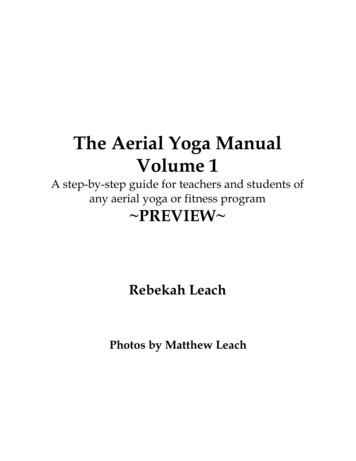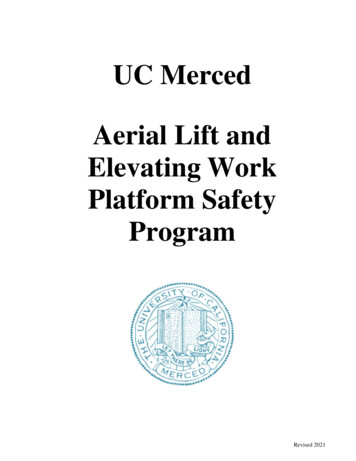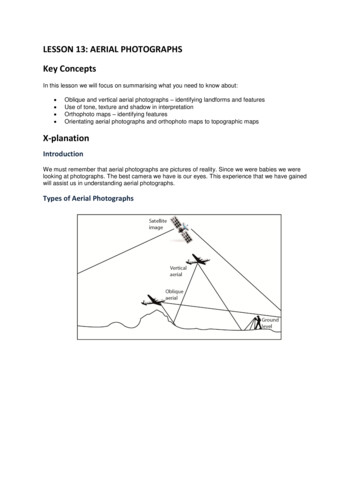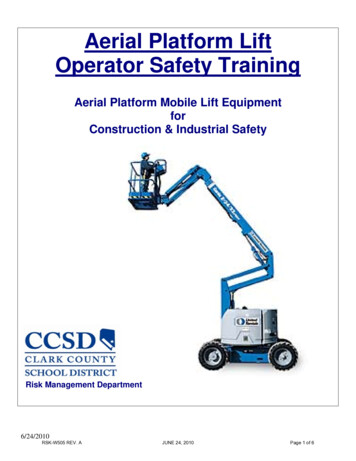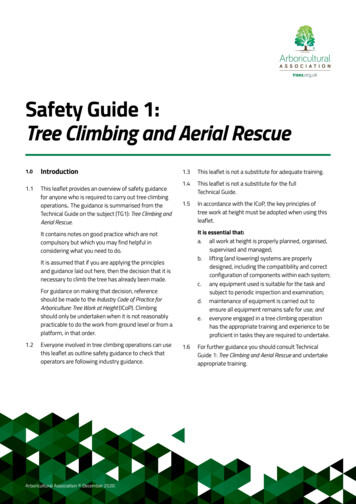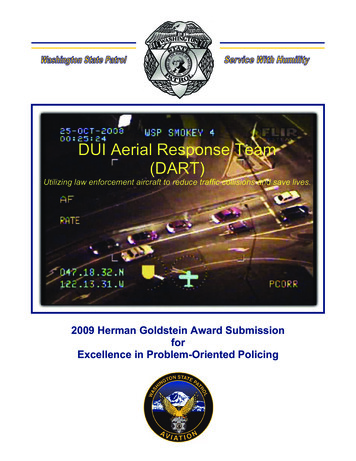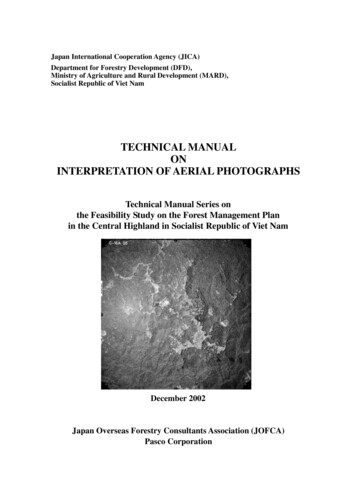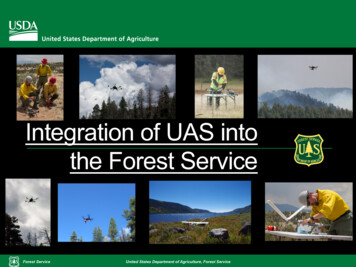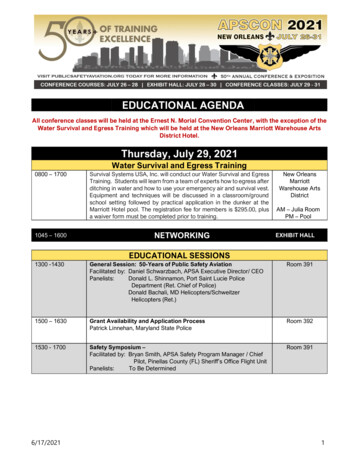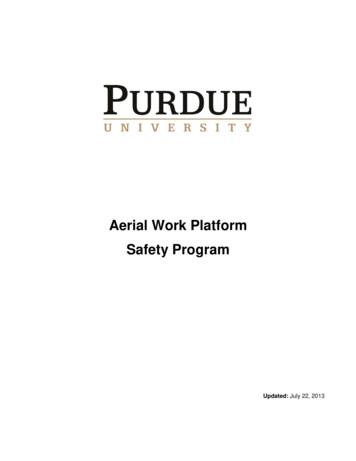
Transcription
Aerial Work PlatformSafety ProgramUpdated: July 22, 2013
Aerial Work Platform Safety ProgramTABLE OF CONTENTSINTRODUCTION .1PURPOSE .1SCOPE .1POLICY .1ENFORCEMENT .1APPLICABLE REGULATIONS AND STANDARDS .2DEFINITIONS .4EQUIPMENT SPECIFICATIONS .5INSPECTION, MAINTENANCE, AND TESTING .5PERMITS AND TRAINING.6HAZARDS .7Electrical Hazards . 7Traffic and Vehicular Hazards . 8Fall Protection . 8OPERATING PROCEDURES .9ACKNOWLEDGEMENT .11The official version of this information will only be maintained in an on-line web format. Review the material on-line prior to placing reliance ona dated printed version.
Aerial Work Platform Safety ProgramINTRODUCTIONWorking above ground on aerial work platforms (AWP) supported by scissors, masts or boomscan result in severe injury or death if safety methods are not followed. For example, the U.S.Bureau of Labor statistics reports that 75 percent of scissor lifts that tipped over resulted infatalities.PURPOSEThis document contains practices and procedures to protect employees from the hazardsassociated with using AWPs.SCOPEThe provisions of this document apply to all personnel at Purdue University’s West Lafayettecampus, regional campuses, university research farms and agricultural centers, and relatedfacilities and operations.POLICYIt is the policy of Purdue University to take every reasonable precaution to provide a workenvironment free from recognized hazards for its employees in accordance with the GeneralDuty Clause of the OSHA act (Public Law 91-596 Section 5(a)(1) and in accordance withspecific OSHA standards. Purdue University’s policy document is entitled EnvironmentalHealth and Safety Compliance.The Director of the department of Radiological and Environmental Management (REM) isresponsible for establishing and maintaining the Aerial Work Platform Safety Program.Appropriate safety equipment (e.g. anchorages, lanyards) must be provided by theUniversity when such equipment is necessary to protect the health and safety of theemployee(s). The supervising department is responsible for the purchase of such equipment.ENFORCEMENTFailure to follow the Purdue University Aerial Work Platform Program can result in lifethreatening or serious injury situations. Failure to follow the Aerial Work Platform Program willresult in disciplinary action up to and including discharge.1The official version of this information will only be maintained in an on-line web format. Review the material on-line prior to placing reliance ona dated printed version.
Aerial Work Platform Safety ProgramAPPLICABLE REGULATIONS AND STANDARDSThis AWP program references OSHA 1926.453 and the latest ANSI A92 standards: ANSI A92.2 – Vehicle-Mounted Elevating and Rotating Aerial Devices (Figure.1)ANSI A92.3 – Manually Propelled Elevating Aerial Platforms (Figure 2)ANSI A92.5 – Boom-Supported Elevating Work Platforms (Figure 3)ANSI A92.6 – Self-Propelled Elevating Work Platforms [Scissor Lifts] (Figure 4)Aerial work platforms must be designed, constructed, and tested so as to be in compliancewith the requirements of the applicable American National Standards Institute standardslisted above.Figure 1Vehicle-Mounted Elevating Work PlatformFigure 2Manually Propelled Elevating Work Platform2The official version of this information will only be maintained in an on-line web format. Review the material on-line prior to placing reliance ona dated printed version.
Aerial Work Platform Safety ProgramFigure 3Boom-Supported Elevating Work PlatformFigure 4Self Propelled Elevating Work Platform3The official version of this information will only be maintained in an on-line web format. Review the material on-line prior to placing reliance ona dated printed version.
Aerial Work Platform Safety ProgramDEFINITIONS“Aerial ladder” means an aerial device that consists of a single- or multiple-section rungladder.“Aerial work platform (AWP)” is defined as a mobile or manually propelled device that hasan adjustable position platform, supported from ground level by a structure.“Articulating boom” means an aerial device that has 2 or more hinged boom sections.“Authorized person” means a person who is approved and assigned to perform specifictypes of duties by the employer and who is qualified to perform those duties because of his orher training or experience.“Commercial chassis” means a vehicle that is built for over-the-road (roadway) travel.“Exposed power line” means a power line that is not isolated or guarded.“Extensible boom” means an aerial device, except for the aerial ladder-type, that has atelescopic boom.“Insulated aerial device” means an aerial work platform that is designed with dielectriccomponents to meet specific electrical insulating ratings.“Mechanically positioned” means that the elevating assembly, whether a mechanical (cableor chain), hydraulic, pneumatic, electric or other powered mechanism, is used to raise or lowerthe platform.“Platform” means the portion of an aerial work platform, such as a bucket, basket, stand,cage, or the equivalent, that is designed to be occupied by personnel.“Power Line” means a distribution or transmission electrical line.“Qualified person” means a person who possesses a recognized degree, certificate,professional standing, or skill and who, by knowledge, training, and experience, hasdemonstrated the ability to deal with problems relating to the subject matter, the work, or theproject."Vehicle" means any carrier that is not manually propelled."Vehicle-mounted elevating and rotating work platform" means an aerial device or aerialwork platform.“Vertical tower” means an aerial device that is designed to operate vertically on a levelsurface.4The official version of this information will only be maintained in an on-line web format. Review the material on-line prior to placing reliance ona dated printed version.
Aerial Work Platform Safety ProgramEQUIPMENT SPECIFICATIONS1. Aerial work platforms must not be field modified for uses other than those intended bythe manufacturer, unless a modification has been certified in writing by themanufacturer or by any other equivalent entity.2. Directional controls must: Be of the type that will automatically return to the off or neutral position whenreleased. Be protected against inadvertent operation. Be clearly marked as to their intended function. An overriding control must be provided in the platform which must becontinuously activated for platform directional controls to be operational andwhich automatically returns to the off position when released.3. Aerial work platforms must be equipped with emergency controls at ground level.4. Emergency ground level controls must be clearly marked as to their intended functionand be capable of overriding the platform controls.5. All of the following information must be clearly marked in a permanent manner on eachaerial work platform: Special workings, cautions, or restrictions necessary for operation. Rated work load. A clear statement of whether or not the aerial work platform is electricallyinsulated.6. Rotating shafts, gears, and other moving parts that are exposed to contact must beguarded, as prescribed in general industry safety standard 29 CFR 1910 Subpart O.7. Attachment points described in 29 CFR 1910.502 must be provided for fall protectiondevices for personnel who occupy the platform on aerial work platforms.INSPECTION, MAINTENANCE, AND TESTING1. Each aerial work platform must be inspected, maintained, repaired, and kept in properworking condition in accordance with the manufacturer’s operating or maintenance andrepair manual or manuals.2. Before use visual equipment inspections must be performed before each shift and mustinclude:a. Cracked welds.b. Bent or broken structural members.c. Hydraulic or fuel leaks.d. Damaged controls and cables.e. Loose wires.5The official version of this information will only be maintained in an on-line web format. Review the material on-line prior to placing reliance ona dated printed version.
Aerial Work Platform Safety Programf. Tire condition.g. Fuel and hydraulic fluid levels.h. Slippery conditions on the platform.3. Any aerial work platform found not to be in a safe operating condition must be removedfrom service until repaired. All repairs must be made by an authorized person inaccordance with the manufacturer’s operating or maintenance and repair manual ormanuals.4. Before and during use visual jobsite inspections must include:a. Ditches.b. Drop-offs.c. Holes.d. Bumps and floor obstructions.e. Debris.f. Overhead obstructions.g. Power lines.5. Any unsafe conditions identified in the jobsite inspection must be corrected prior to theuse of an AWP in the jobsite area.6. If the aerial work platform is rated and used as an insulated aerial device, the electricalinsulating components must be tested for compliance with the rating of the aerial workplatform in accordance with latest ANSI standard A92.2. Such testing must comply withall of the following provisions:a. The test must be performed not less than annually.b. Written, dated, and signed test reports must be retained by the departmentresponsible for the insulated aerial device.c. The insulated portion of an aerial device must not be altered in any manner thatmight reduce its insulating value.7. All danger, caution, and control markings and operational plates must be legible and notobscured.8. A copy of the operator’s manual must be in a dry compartment on the AWP.PERMITS AND TRAINING1. Employees must be trained by a qualified person in the hazards associated with the useof aerial work platforms (AWP) before their use. This training must include safetyguidelines for avoiding hazards above, below, and beside the AWP. Documentation ofthis training must be maintained. The training must include classroom and hands-ontraining.6The official version of this information will only be maintained in an on-line web format. Review the material on-line prior to placing reliance ona dated printed version.
Aerial Work Platform Safety Program2. This training as a minimum must include: Fall protection and job hazardsanalysis Unstable surfaces Live power proximity Tipping hazards and outriggers Falling objects and barricading Load capacity of the AWP Crushing and pinch-points Wind exposure limits Sloping surfaces Ground surface pot holes Operation of the AWP “underthe direction of a qualifiedperson” Controls operationEmergency descent/RescueOperator’s manualPre-operation inspection andrecord keepingIdentification of malfunctionsPurpose of placards and decalsOperator warnings andinstructionsFunction testsEvaluating the work siteHazards unique to the generaltype of AWPIt is expected that departments will provide detailed classroom and hands on training totheir staff based on the general type of AWP that their staff will operate (i.e. vehiclemounted elevating work platform, manually propelled elevating work platform, boomsupported elevating work platform, and self propelled elevating work platform). It is notexpected that multiple detailed training sessions will need to be performed if an operatoris to operate two different manufacturers’ models of a similar type of AWP. Forexample, an operator who is trained to operate self-propelled elevating work platformsdoes not need to attend a detailed training course on a JLG model, if they attendeddetailed classroom and hands on training on a Genie model. However, the trainedoperator is responsible for reviewing the model specific hazard information provided inthe owner’s manual.3. Upon successful completion of the classroom and hands on portions of the AWPtraining the participants will receive an AWP permit. Refresher training is required everythree years.4. Permits must:a. Be carried by AWP operators when operating the equipment he or she has beentrained to operate.b. Be valid for a period not exceeding 3 years.c. Indicate the type of AWP the operator is qualified to operate.HAZARDSElectrical Hazards1. Workers in AWPs that are not electrically insulated must not come within 10 feet ofenergized overhead power lines.7The official version of this information will only be maintained in an on-line web format. Review the material on-line prior to placing reliance ona dated printed version.
Aerial Work Platform Safety Program2. Only specially trained high voltage personnel, with approved PPE and in approvedinsulated AWPs, are authorized to work within 10 feet of energized overhead powerlines.Traffic and Vehicular Hazards1. Before moving a vehicle supporting an aerial ladder for highway travel, employees mustsecure ladders in the lower position and must use the manually operated device at thebase of the ladder, or other effective means to prevent elevation or rotation of theladder.2. Before moving a vehicle supporting an aerial lift for travel, employees must inspect theboom to ensure that it is properly cradled and the outriggers are in the stowed position.3. When a vehicle-mounted elevating platform is elevated with employees in workingposition, the vehicle supporting an aerial device must not be moved.4. Before and during travel, an operator must do all of the following:a. Inspect to see that booms, platforms, aerial ladders, or towers are properlycradled or secured.b. Ensure that outriggers are in a stored position.c. Limit travel speed according to the following factors:i. Condition of the surface.ii. Congestion.iii. Slope.iv. Location of personnel.v. Other hazards.5. Operators of an aerial work platform over or adjacent to any public or private roadwaymust maintain adequate clearances of all portions of the aerial work platform to preventbeing struck by vehicular traffic.Fall Protection1. A permitted operator must use a safety harness that has a lanyard which is incompliance with construction safety standard 1926.502(d) and which is affixed toattachment points provided and approved by the manufacturer. Any occupant of anaerial work platform described in figures 1 and 3 must use the harness. A fall arrestsystem must only be used where the aerial lift is designed to withstand the vertical andlateral loads caused by an arrested fall as specified by the manufacturer.2. A permitted operator may use a body belt with a restraint device with the lanyard andthe anchor arranged so that the employee is not exposed to any fall distance. Anemployee must use a restraint device where the aerial lift cannot withstand the verticaland lateral loads imposed by an arrested fall as specified by the manufacturer.3. A permitted operator is prohibited from belting off to an adjacent pole, structure, orequipment while working from an aerial work platform.8The official version of this information will only be maintained in an on-line web format. Review the material on-line prior to placing reliance ona dated printed version.
Aerial Work Platform Safety Program4. A permitted operator must not exit an elevated aerial work platform, except whereelevated work areas are inaccessible or hazardous to reach. Employees may exit theplatform with the knowledge and consent of the employer. When employees exit tounguarded work areas, fall protection must be provided and used as required inconstruction safety standard 1926.502.5. A means of notifying emergency personnel for the prompt rescue of employees in theevent of a fall must be present on the jobsite. A means for promptly rescuingemployees who have fallen must be determined before the work begins. This couldinclude self-rescue if such means are provided.OPERATING PROCEDURES1. Only trained persons with a permit are allowed to operate an AWP.2. Belting off to an adjacent pole, structure, or equipment while working from an AWP mustnot be permitted.3. Employees must always stand firmly on the floor of the AWP, and must not sit or climbon the edge of AWP guardrails, or use planks, ladders or other devices for a workposition.4. A scissor lift with approved guardrails can be used without a personal fall arrest system.5. The brakes must be set, and when outriggers are used, they must be positioned onpads or a solid surface.6. The aerial work platform must be used only in accordance with the manufacturer’soperating instructions and safety rules.7. The designed rated capacity for a given angle of elevation must not be exceeded.8. The manufacturer’s rated load capacity must not be exceeded. The load and itsdistribution on the platform must be in accordance with the manufacturer’sspecifications. The aerial work platform rated load capacity must not be exceededwhen loads are transferred to the platform at elevated heights.9. Only employees, their tools, and necessary materials must be on or in the platform.10. The guardrail system of the platform must not be used to support materials, other workplatforms, or employees.11. Employees must maintain firm footing on the platform while working on the platform.The use of railings, planks, ladders, or any other devices on the platform for achievingadditional height is prohibited.9The official version of this information will only be maintained in an on-line web format. Review the material on-line prior to placing reliance ona dated printed version.
Aerial Work Platform Safety Program12. Fuel gas cylinders must not be carried on bucket platforms that would allow theaccumulation of gases.13. Only aerial work platforms that are equipped with manufacturer’s installed platformcontrols for horizontal movement may be moved while in the elevated position.14. Before and during driving, an operator of a platform must look in the direction of travel,keep a clear view of the path of travel, and make sure that the path is firm and level. Adriver must avoid:a. Pedestriansg. Rampsb. Vehiclesh. Overhead obstructionsc. Debrisi. Overhead electrical linesd. Drop-offsj. Other hazards to safee. Holeselevated travel.f. Depressions15. Outriggers or stabilizers, when provided, are to be used in accordance with themanufacturer’s instruction. Brakes must be set and outriggers and stabilizers must bepositioned on pads or a solid surface.16. Aerial work platforms must be elevated only when on a firm and level surface or withinthe slope limits allowed by the manufacturer’s instructions.17. A vehicle-mounted aerial work platform (figure 1) must have its brakes set beforeelevating the platform.18. A vehicle-mounted aerial work platform (figure 1) must have wheel chocks installedbefore using the unit on an incline.19. Climbers must not be worn while performing work from an aerial work platform.20. Platform gates must be closed while the platform is in an elevated position.21. Altering, modifying, or disabling safety devices or interlocks is prohibited.22. Care must be taken by the permitted operator to prevent ropes, cords, and hoses frombecoming entangled in the aerial work platform.23. A platform operator must ensure that the area surrounding the aerial work platform isclear of personnel and equipment before lowering the platform.24. The aerial work platform must not be positioned against another object to steady theplatform.25. The aerial work platform must not be operated from a position on a truck, trailer, railwaycar, floating vessel, scaffold, or similar equipment.26. The boom and platform of the aerial work platform must not be used to move or jack thewheels off the ground unless the machine is designed for that purpose by the10The official version of this information will only be maintained in an on-line web format. Review the material on-line prior to placing reliance ona dated printed version.
Aerial Work Platform Safety Programmanufacturer.27. If the platform or elevating assembly becomes caught, snagged, or otherwise preventedfrom normal motion by adjacent structures or other obstacles so that control reversaldoes not free the platform, all employees must exit from the platform before attemptsare made to free the platform.28. Stunt driving and horseplay are prohibited.29. Weather conditions such as wind and lightning must be evaluated prior to raising theboom or platform. Manufacturer’s recommendations for use in windy conditions mustbe followed.ACKNOWLEDGEMENTThis program document is based largely upon the Michigan OSHA Aerial Work PlatformsStandard11The official version of this information will only be maintained in an on-line web format. Review the material on-line prior to placing reliance ona dated printed version.
ANSI A92.5 - Boom-Supported Elevating Work Platforms (Figure 3) ANSI A92.6 - Self-Propelled Elevating Work Platforms [Scissor Lifts] (Figure 4) . detailed classroom and hands on training on a Genie model. However, the trained operator is responsible for reviewing the model specific hazard information provided in the owner's manual.
